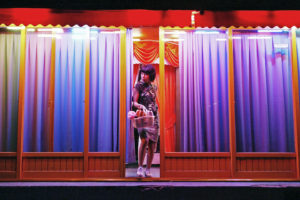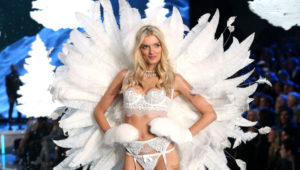It’s always difficult to decide what to buy the toddler in your life for Christmas. A handbag shaped like a teddy dressed in BDSM gear, perhaps? Or a dog collar and lead? In a new ad campaign for the fashion house Balenciaga — now withdrawn and the subject of a lawsuit by the brand against the set designer — lonely and disassociated-looking infants stare vacantly into the camera, surrounded by an array of distinctly unchildlike objects, each with a fetish teddy bag lurking queasily nearby. The vibe is hardly festive.
Recently, the label has made multiple forays into the gothic, not least by mining the aesthetics of climate collapse for several recent shows. (As one women’s magazine enthused: “Balenciaga brought the apocalypse to Paris and we’re here for it.”) So perhaps brand managers expected the disturbing imagery of young kids surrounded by bondage gear to be treated as just another subversive juxtaposition in the service of selling things. This time, however, the bourgeois were not so much thrillingly épaté as absolutely bloody incandescent — because they assumed that childhood itself was being sold.
Internet sleuths quickly tracked down details of an earlier Balenciaga campaign, in which background props had included a Supreme Court ruling on the illegality of child pornography, as well as a book by an artist controversial for depicting tortured children in his work. The two separate campaigns were quickly conflated by commentators, jointly presented as a case of paedophilic imagery gloating lasciviously in plain sight. Some observers went further, interpreting the placing of lettered packing tape in the most recent campaign as spelling out a reference to Baal, the Canaanite god who demanded child sacrifices.
In some quarters of the populist Right, where the legacy of QAnon still looms large, Christmas had come early. Tucker Carlson weighed in, bravely putting his own history of joking about child rape behind him, to connect the incident to groomer discourse and admonish the world to “stop sexualising kids”. Creepy geezer-bro Andrew Tate argued that Balenciaga was being deliberately open and explicit about paedophilic sympathies because the “people who are in charge of these brands, and of the Western world” are “Satanists” who deliberately “tell you what they are doing” in order to avoid karmic retribution for their sins. (Any reflection by Tate on earlier frank admissions of his that “I am absolutely sexist and I’m absolutely a misogynist” went unrecorded.)
Though — of course — I don’t know the truth of what actually happened at Balenciaga, it seems to me that the “deliberately paedophilic” interpretation is probably wrong. But that doesn’t mean the whole thing was an accident. As others have suggested, rather than acting as a direct manifestation of a paedophile conspiracy, it seems more likely that the campaigns were offering knowing nods to the aesthetics of paedophile conspiracies. Viewed in this light, the problem is not so much the imagery but that the proles on the internet hadn’t done a Masters in Visual Cultures at Goldsmiths.
This interpretation is in keeping with the modus operandi of high fashion. The higher the couture, and the more luxurious the brand, the more effort must be made to signal this status to the world. One traditional way to do this is by using hand-embroidered silks and other gorgeous fabrics to make clothes. But a reality-transcending brand image can also be achieved by dressing women up in totally impractical garments they can’t walk or get through doors in, or — as Balenciaga also recently did — by inducing a celebrity such as Kim Kardashian to wear ridiculous facemasks in public on a number of occasions.
As Louise Perry has argued, fears about paedophilia are often viewed by liberals as classically low-status, and associated by them with the “ignorant and credulous working classes”. And so, ironically sneering about low-status cultural fears about paedophiles, in a way only detectable to a few knowing onlookers, is automatically high-status. Job done. Or it would have been, had it not proved understandably impossible for most onlookers to tell the difference between representation and reality.
As with Balenciaga’s attraction to the gothic, the fashion world more generally has long played about with savagery and psychic darkness for the purposes of selling people things they don’t need. In practice this often means glamourising various terrible things done to women. Alexander McQueen’s first two (visually stunning) collections were called “Jack the Ripper and his Victims” and “The Highland Rapes”. A 2007 Dolce & Gabbana ad campaign was highly suggestive of gang rape, and a 2003 Sisley campaign of bestiality between a woman and a bull.
Generally speaking, the fashion industry is littered with pictures of young women with a sexualised, exploited, fetishised, or downright quasi-paedophilic vibe. And female consumers apparently lap it up — perhaps because they tell themselves, accurately, that promoting abusive sex is not the direct point. As with everything else in the fashion world, nothing is positively asserted, but only referred to obliquely or quoted in order to generate interest in the clothes.
Yet when you look at some of the blank-eyed skeletal young models who still tend to be preferred by designers, it’s impossible to maintain that the casual brutality dished out to women in the representational realm of fashion doesn’t have consequences for the real one. Models are treated by the fashion world as living dolls you can pick from a book purely on the basis of appearance, then dress them up, choose their poses, control their food intake, and fly them around the world to serve you, until you don’t want them anymore. Granted, not every model is skinny or young these days, but even those who aren’t are just as heavily objectified — every personalised aspect of them being diminished to a commercially favourable appearance, interchangeable with some other commercially favourable appearance, should the originally-booked girl have a breakdown or get a breakout.
But at least most models are adults, technically anyway. For me, an under-explored aspect of the Balenciaga scandal is the apparent fact that parents somewhere have let their very young children be photographed in these campaigns. It is bad enough to represent grown adults as slack-jawed, vacant children, but a lot worse to turn children into slack-jawed, vacant little adults. Generally speaking, I marvel in horror at parents who use their children to make money by modelling or acting in adverts. No matter how much fun children allegedly have doing it, or how much money goes into their trust funds because of it, there is nothing about having one’s appearance objectified by strangers for money that’s compatible with healthy childhood development.
And of course, it’s not just commercial modelling. Famous for admonishing us against using other humans as mere means to our ends, Kant also warned that “parents cannot regard their child as, in a manner, a thing of their own making”. Then again, he wasn’t on Insta. The internet is full of influencers using their own children for likes and clicks. If social media has turned many of us into narcissists, then it seems to have turned our children into narcissistic extensions of ourselves — only there to say something flattering about who we are. A generation of kids are growing up, made supremely conscious of how their bodies and faces look as they go about their daily lives, before they really know anything else about themselves. And we made them that way.
Moral panics get off the ground partly because they pick up on unconscious forces genuinely rippling through a culture. It doesn’t seem to me a coincidence that there’s increasing prurient interest in paedophilia and grooming at the moment, when at the same time there have never been so many culturally acceptable ways to objectify your own child. Paedophilia — which of course exists, and nobody should pretend different — involves the egregious and permanently life-changing treatment of a living human child as a sexual object. But there are subtler ways to use children as means to adult ends. We can sign them up to a modelling agency. We can put them in a beauty pageant. We can upload their pictures with amusing captions on Facebook, in a way that makes us look like good parents.
So the original fear about Balenciaga — that they are selling kids — was perhaps not entirely wrong. If not kids, then collectively we are at least selling childhoods. And the hideous teddy bear fetish bags highlighted in the doomed ad campaign now seem to me to be an uncannily apt symbol of what we are doing. A much-beloved figure, originally invested with so much innocence, joy, and love, now turned into something to be used.
Disclaimer
Some of the posts we share are controversial and we do not necessarily agree with them in the whole extend. Sometimes we agree with the content or part of it but we do not agree with the narration or language. Nevertheless we find them somehow interesting, valuable and/or informative or we share them, because we strongly believe in freedom of speech, free press and journalism. We strongly encourage you to have a critical approach to all the content, do your own research and analysis to build your own opinion.
We would be glad to have your feedback.
Source: UnHerd Read the original article here: https://unherd.com/




